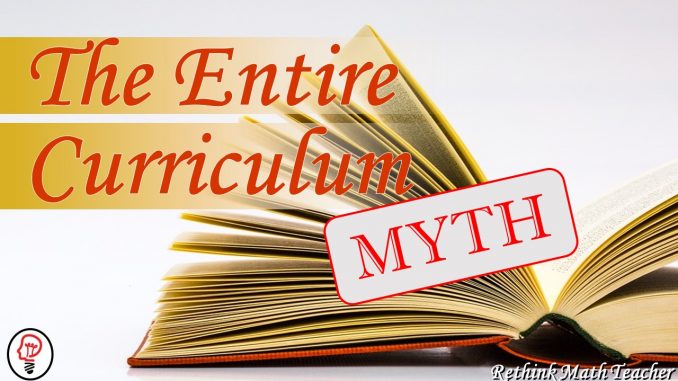
ARE WE FOCUSSED ON THE GROWTH?
For years I fell victim to ‘the entire curriculum in a year myth.’ It caused me to rush through lessons, freak out when I stared at a pacing calendar, force my students to move on before they were ready, not use the date I collected, and leave so many of my students behind who needed extra time or remediation.
Hi, my names Chris, I’m a recovering Curriculum-in-a-year teacher.

Warning, this will be a controversial post, because the myth of the entire curriculum has become entangled into the fabric of our pedagogical conscience, and trying to disentangle it causes all sorts of resistance.
Second warning, the next section is going to get geeky with data.
If you don’t care about data and want to cut to the good stuff, skip the next section (you have my permission).
The Truth About Proficiency Scores
I teach in Florida, United States. But I have a suspicion that what is true in my state is true in the other 49 in the USA, and likely true for other countries as well.
All of my information is taken from the FLDOE website.
- The students’ end of year scores are rated against each other. So it’s not how many questions they answer correctly, its how many they get right compared to the other students in the state.
This means that the elusive score of “proficiency” is a moving target.
- The score distribution of students’ scores across the state looks much like a bell curve.
- I hope you’re sitting down. Regardless of what grade you are teaching, to get a score equivalent to “on grade level” (or passing) your students typically need to get between 35-55% of the questions correct.
I’ll say it again. 35-55% correct is considered on grade level. Don’t believe me, watch how Florida will curve the midterms every year (because that number, they will broadcast).

Something to think about
In my state, students earn a score of 1-5 on the end of year assessment. A level 3 is on grade level, and 1 or 2 is below grade level.
If 50% correct is a level 3, on grade level. What percentage correct do you think level 2’s get? How many questions are your level 1 students earning? How about your low-level 1’s?
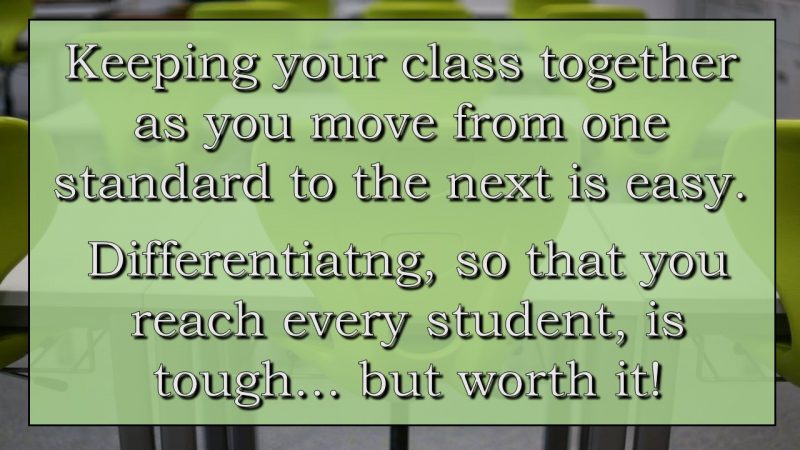
The Talk
Every year I sit with my math teachers and we talk about this data. I show them graphs and documents from the Florida Department of Education, and we spend some time considering these percentages. Then we look at students in our school who are in the bottom 25%.
We look at their scores and consider how many questions those students probably got correct. Considering that these tests are 120 questions, covering a little more than 20 standards, we assume that most of these students got less than 15 questions right. Meaning they probably mastered 1-2 standards (maybe 3).
I then have ‘the talk.’
I tell my teachers that these students are probably years behind and to get them to a level 3 is probably unrealistic, though it would be nice (and it is not impossible). But our goal is to get growth out of them. I’d like them to go from mastering 2 standards to mastering 5. I look at my teachers and say, ‘you’ve got this kid for a whole year. Do you think you can get him to master 5 standards?’
Reaching Your Lowest Students
Of course, we all believe that we can get those low students to master just a few standards and justify a learning gain. But we don’t consider how difficult that is. You can’t just teach him the standard, you have to remediate all those standards that are being built upon to master this standard.
You can’t just teach him how to add fractions, he has to know how to simplify fractions and find the common denominators. And to do that he has to know his times tables. That’s a lot of work!
And what are you doing with the rest of your class while you are remediating these students?
Maybe now you see why we are focussing on learning stations and differentiated instruction. You can reach these low leveled students, but you have to have a solid game plan. An action plan to remediate them, while not abandoning the rest of the class.

An Epiphany
One year, while teaching Pre-Algebra, I was working on the standard that has the students memorize three volume formulas (sphere, cone, and cylinder). In Florida, it’s 8.G.3.9.
My students were really struggling. It’s a tough one. The formulas aren’t easy. And if the students memorize all three correctly, the test will still ask them to find the volume of half a sphere that has a cone taken out of it! It’s so tricky.
Anyhow, my students were struggling to memorize the three formulas. I started to consider that memorizing three formulas might be difficult for them. And if I could get them to memorize three formulas, I would prefer they memorize the Pythagorean Theorem, Linear equations, and the formula for slope. These three formulas appear in multiple standards, thus they represent a greater proportion of the end of year assessment. So mastering those three are of greater value than the three volume formulas that only represent one standard on the assessment!
So, from that day on, I did not try to get my lower students to learn this standard. If, however, they were a stronger student, and my goal was to for them to get a much higher score, then absolutely they had to learn these formulas. But my weaker students, the ones struggling with two-step equations and graphing linear equations, they needed more time on these other standards, then they needed on 8.G.3.9.
Give them As Long As They Need
In our last blog post here at Rethink Math Teacher, we talked about how some students learn at a different pace than others. And they are often being drug from one standard to the next before they have fully mastered it and are ready to be moved on. So they are not fully learning the material and they fall farther behind with each new lesson.
So I encouraged you to give your students as long as they need to master the skill. But you can’t do that if you’re trying to get them through the entire curriculum before the end of the year.
They Don’t Need the Entire Curriculum
It’s okay if you don’t get your weaker students through the entire curriculum this year. They don’t need it. If your goal is to get growth out of them, then give them as long as they need – and if they don’t get exposure to every standard, that’s okay.
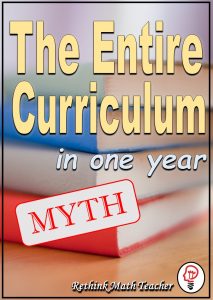
If you found this helpful, share it with your friends
But they won’t be prepared for next year
Okay, really???
How many of the students in your class this year entered the room knowing everything they needed to know for their current grade? I’m betting very few. I’m betting you’re looking at some of your students and wondering, “what did you learn last year?”
But now they are your responsiblity. Are you going to drag them through the whole curriculum, as their previous teacher did, or are you going to work with them and help them be successful at a few things, and get growth out of them?
I’ve got a ninth-grade student this year who tested at a Kindergarten level. Honestly! Kindergarten. That’s basic counting and 1 digit addition!!! What hope does he have at passing his Algebra 1 exam this year? Will he really get any value out memorizing the quadratic formula, or understanding the constant rate of change in an exponential growth function? No. What’s going to help him is gaining some basic number sense and fluency. So that’s how we’re servicing him.
A Simple Question
What’s of greater value?
A – your students seeing all the material in the textbook this year, but learning little of it
OR
B – your students seeing some (or most) of the curriculum, but knowing all of it
I propose that the second option will be better for the students (who will have learned more), better for your school (because they will obtain higher test scores), better for you (because that student will behave better in your class because he/she knows that you care), and better for whoever teaches that student next year (as they will enter the room with some foundational knowledge.)
Whole Group Pacing is Easy
Keeping the entire class together as you move from one standard to the next is easy. You can give everyone the same practice problems, the same amount of time, and the same test.
But all your students are not the same. They’re all unique. Some learn faster than others, some require more practice than others, and many did not master different skills from previous years that are needed to do the grade level work in your class.
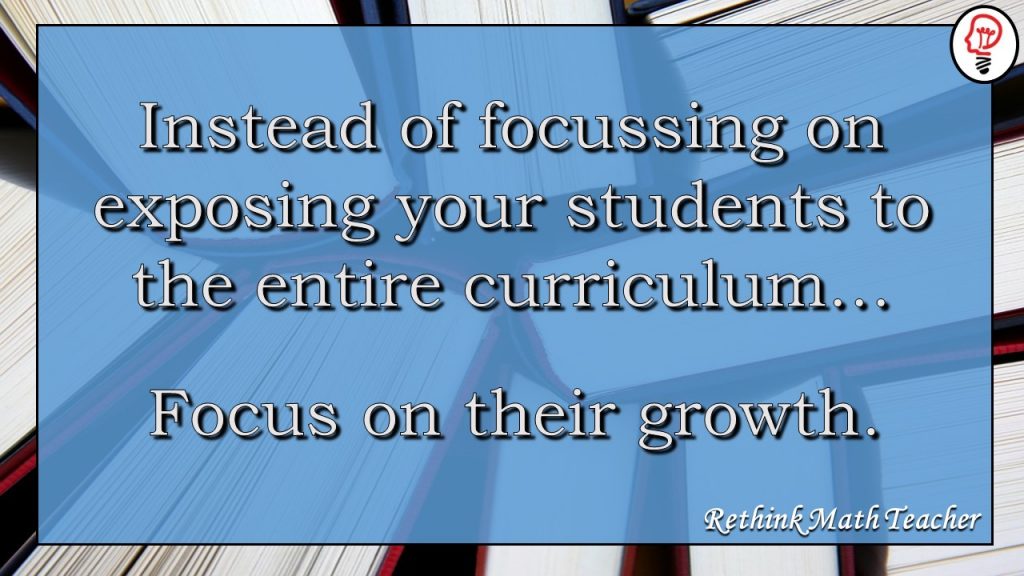
Focus on the Growth
Instead of focussing on exposing your class to the entire curriculum, focus on the growth.
But this is easier said than done.
Keeping your entire class together as you go from one chapter to the next is easy. Differentiating your instruction so that you reach every student and get growth out of each one is tough. But it is so worth it.
I would like to help you be successful at this.
Join me on a journey, where you will be traveling with math teachers around the world as we think through our differentiation so that we can reach every student in the room.
To get you started on this journey (or to keep you going if you’re already on it), I’d like to give you this growth checklist. See how you’re doing. Are you focused on student growth, or something else?
Download the free resource below, and then learn more about The Journey
Free Resource
To help you on your journey to focus on student growth, download our free checklist. By downloading it, you will automatically receive our weekly newsletter full of tips and resources. Currently, the emails are full of tools to help you along this journey.
Click here, or on the image, to get the checklist for free
What’s Next?
1) Take the Uncommon Teacher Challenge
I’d like to send you 10 free teaching resources to help you become an Uncommon Teacher. Do things different than most teachers and get uncommon results. The Uncommon Teacher Challenge includes 10 articles, with 10 resources, and 10 different strategies to help you reach all your students.
Enroll in the Uncommon Teacher Challenge

2) Reach Them All
Reach Them All is a book that will walk you through a step by step process of how to create and implement learning stations in your class that will help you differentiate your remediation so that you can effectively impact every student in the room by meeting them where they are and helping them grow through skills based learning stations.
Learn more about Reach Them All here.
3) The Online Course
We are now offering a 3 Part Online Course that will walk you through the process of creating learning stations that will target students’ weaknesses, build them up, until the student is proficient at grade level skills.
There learning stations will give a reteach, lots of practice with immediate feedback, and not punish students for making mistakes.
Learn more about the online course here.
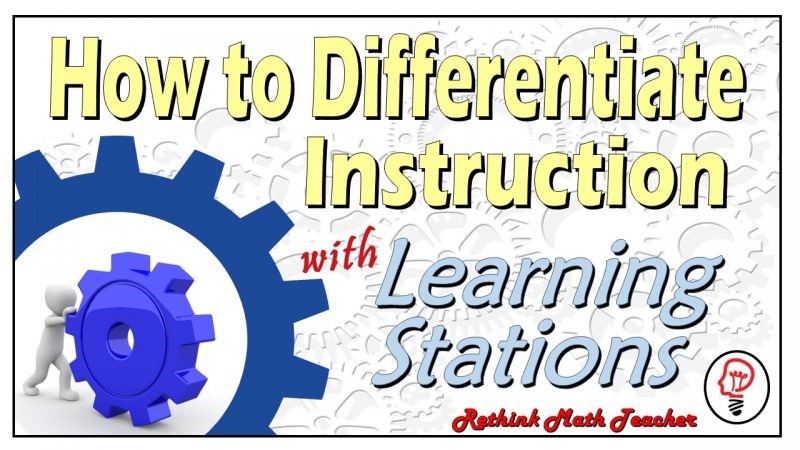
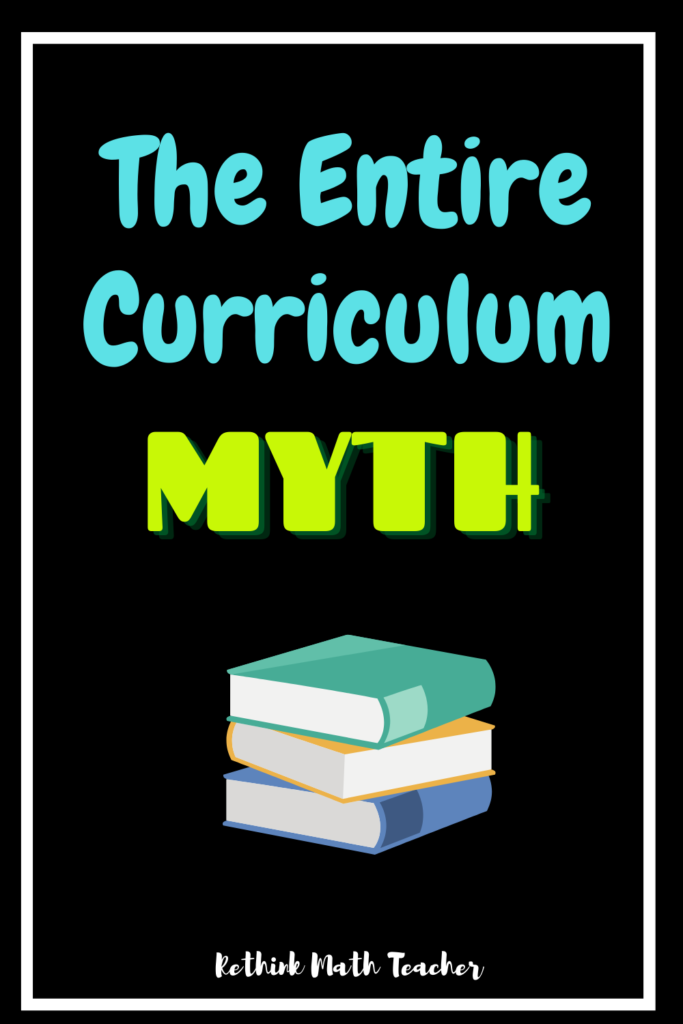



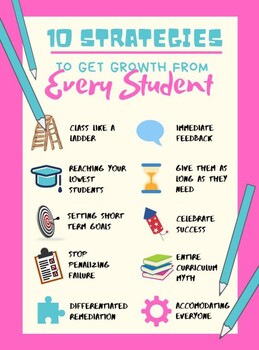

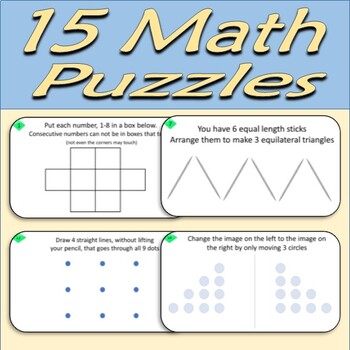
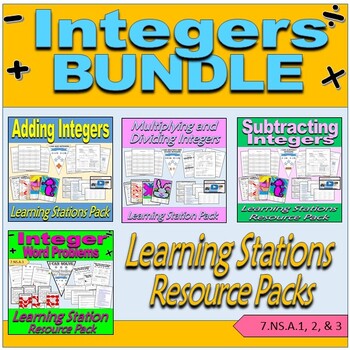
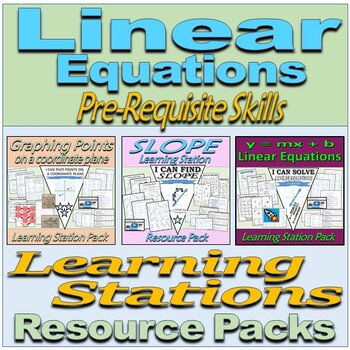
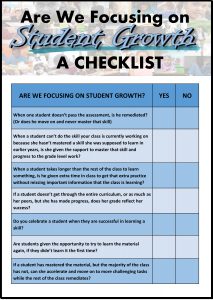
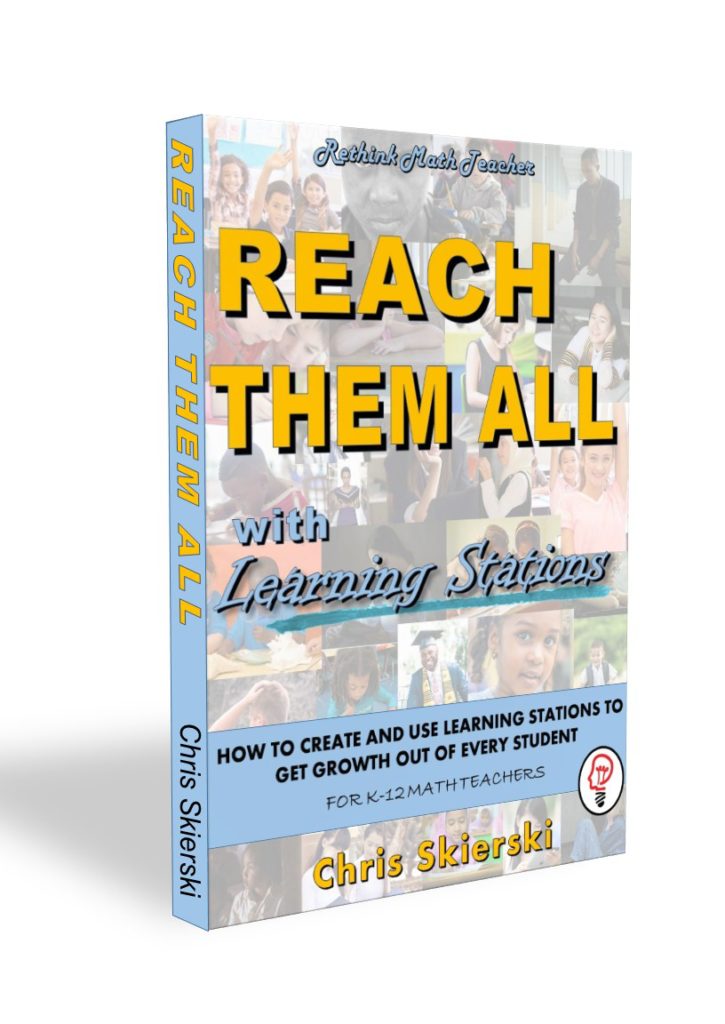
There is so much here that I agree with. But if you have a student that has spent the whole year mastering elementary grade arithmetic, does his transcript show a passing grade for Algebra 1? There must be some sense that the class title indicates the body of knowledge that the student studied. I have a few students in my Algebra 1 class whose transcripts will say ‘Basic Algebra’ to indicate that there have been modifications made in the expectations for them.